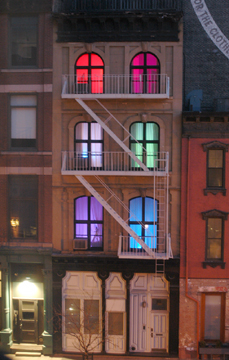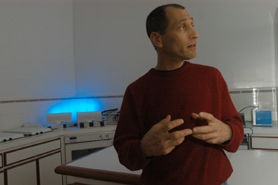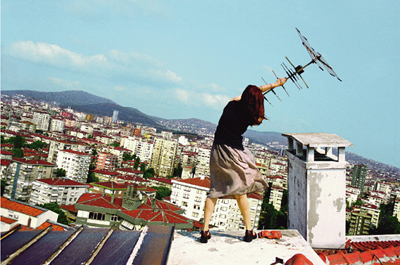| In His Own (Art) World
By Andrea Appleton
POSTED FEB. 2, 2007
During the day 289 Church Street is easy to miss, a narrow four-story structure blending in with the other loft buildings on the block. But when night falls, it comes mysteriously to life. One after another the windows glow in the soft tones of the Northern Lights, in tangerine, turquoise, violet, fuchsia.
Despite appearances, the building is neither disco nor hip new bar. It is the studio of artist Steven Rand, the owner of the building, who set the lights pulsating more than six months ago. Rand makes no pretense about his glowing facade. He doesn’t call it art. But he notes that it does use a similar programmable LED system as a larger, more conceptual work of his in Germany.
There, Rand created a permanent installation for a patent office in Munich. The lights pulse through the same color cycle as the Tribeca lights, albeit more than 500,000 times slower, traveling through the entire color spectrum by changing imperceptibly every two seconds. No color appears twice in the course of an entire year.
“The piece was meant to give the building an organic quality,” says Rand, who won a competition to create the installation. “The idea is to keep people who see it all the time seeing something new.”
Rand’s art, as one reviewer put it, “eludes clear-cut categorization.” Sometimes he works with thermographic film, which changes in response to temperature. For one show, he set a huge block of melting ice on a sheet of the film.He has made pointilistic-like pieces out of Formica sample chips, the shades of which change every season depending on what color countertops are in style.
|
|
|
His video work includes a two-and-a-half minute piece on how to make bread.
Next door to Rand’s studio is 291 Church Street, a building he owns. His home is upstairs, and downstairs is apexart, a noncommercial gallery he founded in 1994. The not-for-profit space includes a residency program, a conference series, and public programming, as well as exhibitions whose curatorial rules are often unorthodox.
|
“Apex clearly is a reaction against a lot of the commercialism happening in the art world right now,” says Rand. “Artists have become consummate business people and too often the art looks like it was made to be sold.”
Apexart does not sell any artwork, or deal directly with artists. Rand declines to say how his various projects are funded, though he pointed out that numerous foundations and governmental organizations support apexart.
True to his belief in a democratic art space, Rand has no hand in the selection of artists. |
|
|
And every show sees a different curator, some of whom have little gallery experience. Past curators have included philosophy professors, art historians, and writers. Apexart also regularly accepts unsolicited proposals. No curatorial experience is necessary and applicants may only send in a one page idea. Images are prohibited. (Proposals are being accepted through Feb. 15 for next season. Go to www.apexart.org for more information.)
|
“Apex is wonderful,” said former Newsday art critic Amei Wallach, who curated an apexart show last year called “Neo-Sincerity: The Difference Between the Comic and the Cosmic is a Single Letter.” “I’m a good example of what they do. They go to people you wouldn’t normally think of.”
Wallach’s show, which the brochure describes as being about the trend toward “sincerity built on a thorough grounding in irony,” included pieces by Art Spiegelman and more than 20 others, and won an award from the International Association of Art Critics. |
|
|
Apexart exhibitions are usually explorations of an idea, and they’re often provocative. For a recent (non-curated) exhibit entitled “Thanks: Returning the Favor,” 10 artists were commissioned to produce original works, as gifts to 10 arts philanthropists. The topic was meant to foment discussion about the relationship between philanthropy, money, and art. By those standards, the show was wildly successful.
“I have to be honest,” one artist wrote, “I really don’t understand this at all. The premise is that I give away my work to a billionaire who would never buy it?” Another artist refused to create an original piece, and several philanthropists declined their gifts.
Typical of apexart, the discord became part of the show. The entire prickly correspondence between the gallery and one recalcitrant artist appeared in the exhibition’s brochure.
|
Rand says the art world serves itself best by “constantly reassessing itself.” For him, that often means expanding the definition of “art.”
“I don’t see a lot of artists taking chances,” he says. “I see Jon Stewart, Stephen Colbert, and South Park as the subversive mediums that artists used to be.”
As usual, Rand is putting his money where his mouth is. The creators of “Drawn Together,” a Comedy Central show, will curate the next apexart exhibition, opening Feb. 21.
|
|
|
|
[Home][Back][Search] [Advertise][Contact] |
|





